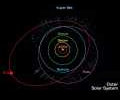Solar System -
Trans-Neptunian Objects
Just beyond the Kuiper Belt lie the Scattered Disk Objects (SDO), which, while generally within the gravitational influence of Neptune, have much more eccentric orbits, that tend to be much more inclined to the plane of the Solar System. They are found from about 3 billion miles to at least 20 billion and possibly as much as 90 billion miles from the Sun. Some of the orbits come within the zone of the Kuiper Belt at their closest approach to the sun, but if Neptune happens not to be close by, they continue on their journey far into the outer limits of the Solar System.
Eris, originally photographed in 2003, and formally discovered on January 5th 2005, is the largest SDO discovered so far, and is about 4% to 8% larger than Pluto, while weighing about 27% more. Its closest approach to the sun is around 5.65 billion km (3.5 billion miles), and it is around 14.66 billion km (9.1 billion miles) away at its furthest. It goes around the Sun once every 557 years. Eris has one small moon, Dysnomia which is between 100 and 250 km (60 to 150 miles) across.
Sedna, disvovered in November 2003, falls somewhere between SDO, and Oort cloud object, and is often classified as a Detached or Inner Oort Cloud Object. Its closest approach to the sun is 11.4 billion km (7 billion miles), which it will reach in 2075/6, but it is 143.7 billion km (89.3 billion miles) away at its furthest. It takes nearly 12,000 years to go once around the sun, and is between 1,200 & 1,600 km (750 & 1,000 miles) across.
Most planetary astronomers believe that SDOs originated in the Kuiper Belt, and were ejected following close encounters with Neptune. They also suggest that the majority of periodic comets we see originate in the scattered disk. The Centaurs, which are cis-Neptunian objects, are probably the intermediate stage where dislocated SDOs reside temporarily before continuing into the inner Solar System, having been perturbed by the gas giant planets. Thus we see a pattern of objects moving outwards from the Kuiper Belt then back inwards closer than the Kuiper Belt, becoming comets.
Another class of TNOs is the Detached Objects which orbit beyond the influence of Neptune and the other planets, but closer in than the Oort Cloud, overlapping with the SDOs. 2004 XR190 (Buffy) is a possible DO, as is Sedna, though Sedna may belong to the Inner Oort Cloud.
Eris, originally photographed in 2003, and formally discovered on January 5th 2005, is the largest SDO discovered so far, and is about 4% to 8% larger than Pluto, while weighing about 27% more. Its closest approach to the sun is around 5.65 billion km (3.5 billion miles), and it is around 14.66 billion km (9.1 billion miles) away at its furthest. It goes around the Sun once every 557 years. Eris has one small moon, Dysnomia which is between 100 and 250 km (60 to 150 miles) across.
Sedna, disvovered in November 2003, falls somewhere between SDO, and Oort cloud object, and is often classified as a Detached or Inner Oort Cloud Object. Its closest approach to the sun is 11.4 billion km (7 billion miles), which it will reach in 2075/6, but it is 143.7 billion km (89.3 billion miles) away at its furthest. It takes nearly 12,000 years to go once around the sun, and is between 1,200 & 1,600 km (750 & 1,000 miles) across.
Most planetary astronomers believe that SDOs originated in the Kuiper Belt, and were ejected following close encounters with Neptune. They also suggest that the majority of periodic comets we see originate in the scattered disk. The Centaurs, which are cis-Neptunian objects, are probably the intermediate stage where dislocated SDOs reside temporarily before continuing into the inner Solar System, having been perturbed by the gas giant planets. Thus we see a pattern of objects moving outwards from the Kuiper Belt then back inwards closer than the Kuiper Belt, becoming comets.
Another class of TNOs is the Detached Objects which orbit beyond the influence of Neptune and the other planets, but closer in than the Oort Cloud, overlapping with the SDOs. 2004 XR190 (Buffy) is a possible DO, as is Sedna, though Sedna may belong to the Inner Oort Cloud.
Scattered Disk Objects (SDOs)
Eris
An image of the dwarf planet Eris, the largest known scattered disc object (in the center), and its moon Dysnomia (to the left). Taken by the Hubble Space Telescope. Credit: NASA.
Eris Orbit
The orbit of Eris showing how it is both highly eccentric, and at a steep angle to the ecliptic. At its furthest, it is nearly 100 times further from the Sun than is the Earth.
Credit: NASA
Sedna Orbit
The orbit of Sedna with respect to the outer planets of the Solar System, and Pluto. Also shows the current position of Sedna in its orbit, in 2010, as it approaches its perihelion .
Credit: NASA/JPL





